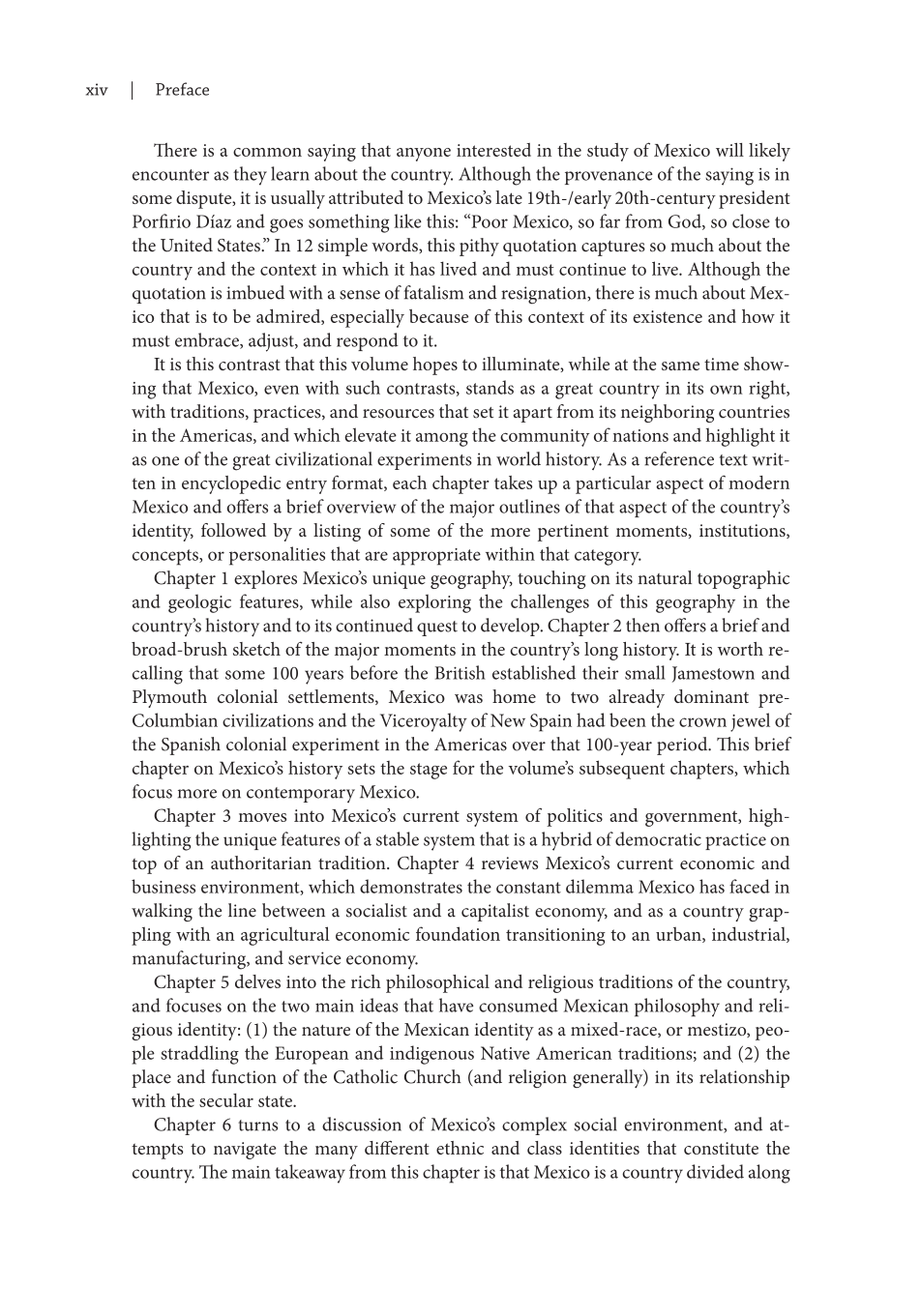xiv | Preface
There is a common saying that anyone interested in the study of Mexico will likely
encounter as they learn about the country. Although the provenance of the saying is in
some dispute, it is usually attributed to Mexico’s late 19th-/early 20th-century president
Porfirio Díaz and goes something like this: “Poor Mexico, so far from God, so close to
the United States.” In 12 simple words, this pithy quotation captures so much about the
country and the context in which it has lived and must continue to live. Although the
quotation is imbued with a sense of fatalism and resignation, there is much about Mex-
ico that is to be admired, especially because of this context of its existence and how it
must embrace, adjust, and respond to it.
It is this contrast that this volume hopes to illuminate, while at the same time show-
ing that Mexico, even with such contrasts, stands as a great country in its own right,
with traditions, practices, and resources that set it apart from its neighboring countries
in the Americas, and which elevate it among the community of nations and highlight it
as one of the great civilizational experiments in world history. As a reference text writ-
ten in encyclopedic entry format, each chapter takes up a particular aspect of modern
Mexico and offers a brief overview of the major outlines of that aspect of the country’s
identity, followed by a listing of some of the more pertinent moments, institutions,
concepts, or personalities that are appropriate within that category.
Chapter 1 explores Mexico’s unique geography, touching on its natural topographic
and geologic features, while also exploring the challenges of this geography in the
country’s history and to its continued quest to develop. Chapter 2 then offers a brief and
broad-brush sketch of the major moments in the country’s long history. It is worth re-
calling that some 100 years before the British established their small Jamestown and
Plymouth colonial settlements, Mexico was home to two already dominant pre-
Columbian civilizations and the Viceroyalty of New Spain had been the crown jewel of
the Spanish colonial experiment in the Americas over that 100-year period. This brief
chapter on Mexico’s history sets the stage for the volume’s subsequent chapters, which
focus more on contemporary Mexico.
Chapter 3 moves into Mexico’s current system of politics and government, high-
lighting the unique features of a stable system that is a hybrid of democratic practice on
top of an authoritarian tradition. Chapter 4 reviews Mexico’s current economic and
business environment, which demonstrates the constant dilemma Mexico has faced in
walking the line between a socialist and a capitalist economy, and as a country grap-
pling with an agricultural economic foundation transitioning to an urban, industrial,
manufacturing, and service economy.
Chapter 5 delves into the rich philosophical and religious traditions of the country,
and focuses on the two main ideas that have consumed Mexican philosophy and reli-
gious identity: (1) the nature of the Mexican identity as a mixed-race, or mestizo, peo-
ple straddling the European and indigenous Native American traditions; and (2) the
place and function of the Catholic Church (and religion generally) in its relationship
with the secular state.
Chapter 6 turns to a discussion of Mexico’s complex social environment, and at-
tempts to navigate the many different ethnic and class identities that constitute the
country. The main takeaway from this chapter is that Mexico is a country divided along

































































































































































































































































































































































































